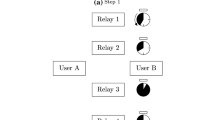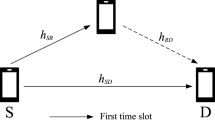Abstract
A well-known dilemma in large-scale cooperative systems is that the use of more relays can boost reception reliability but consume extra bandwidth resources due to the coordination among the relays. In this paper, the tradeoff between performance and complexity is studied in large-scale decode-and-forward (DF) relay systems. First, the cumulative distribution function (CDF) of the sum of the K-largest order statistics of N independent exponential random variables is developed. By using this result, the impact of different cooperation strategies to exploit relays on the tradeoff between system performance and complexity can be characterized. In particular, explicit expressions for the outage probability and the expected number of the used relays employed can be obtained for these strategies, and facilitate asymptotic studies of the addressed large-scale cooperative network. Then the performance of relay cooperation is also evaluated with the presence of channel estimation error. Finally, numerical results are provided to verify the accuracy of the developed theoretic results, and also demonstrate the performance and the complexity achieved by different relay cooperation strategies.








Similar content being viewed by others
Notes
As shown by the evaluation results in [19, 20], the spatial correlation between different antennas can be negligible when the distance is large than 6λ, where λ is the wave length. Since the distance between different relays is much larger than that, it is reasonable to assume that spatial correlation can be neglected.
References
Chen, S., & Zhao, J. (2014). The Requirements, challenges and technologies for 5G of terrestrial mobile telecommunication. IEEE Communications Magazine, 52(5), 36–43.
Peng, M., Li, Y., Zhao, Z., & Wang, C. (2015). System architecture and key technologies for 5G heterogeneous cloud radio access networks. IEEE Network, 29(2), 6–14.
Peng, M., & Wang, W. (2009). Technologies and standards for TD-SCDMA evolutions to IMTAdvanced. IEEE Communications Magazine, 47(12), 50–58.
Peng, M., Liu, Y., Wei, D., Wang, W., & Chen, H. (2011). Hierarchical cooperative relay based heterogeneous networks. IEEE Wireless Communications, 18(3), 48–56.
Peng, M., Wang, C., Li, J., Xiang, H., & Lau, V. (2015). Recent advances in underlay heterogeneous networks: Interference control, resource allocation, and self-organization. IEEE Communication Surveys and Tutorials, 17(2), 700–729. second quarter.
Jin, S., Liang, X., Wong, K.-K., Gao, X., & Zhu, Q. (2014). Ergodic rate analysis for multipair massive MIMO two-way relay networks. IEEE Transactions on Wireless Communications, 14(3), 1480–1491.
Liu, H., Gao, H., Zhang, C., & Lv, T. (2014). Low-complexity joint antenna tilting and user scheduling for large-scale ZF relaying. IEEE Signal Processing Letters, 22(3), 361–365.
Atapattu, S., Rajatheva, N., & Tellambura, C. (2010). Performance analysis of TDMA relay protocols over Nakagami-m fading. IEEE Transactions on Vehicular Technology, 59(1), 93–104.
Nasri, A., Schober, R., & Uysal, M. (2012). Enhanced MRC for decode-and-forward cooperative diversity systems. IEEE Transactions on Wireless Communications, 11(10), 3418–3423.
Zou, Y., Yao, Y.-D., & Zheng, B. (2012). Diversity-multiplexing tradeoff in selective cooperation for cognitive radio. IEEE Transactions on Communications, 60(9), 2467–2481.
Fan, Y., & Thompson, J. (2007). MIMO configurations for relay channels: theory and practice. IEEE Transactions on Wireless Communications, 6(5), 1774–1786.
Bletsas, A., Shin, H., & Win, M.Z. (2007). Cooperative communications with outage-optimal opportunistic relaying,”. IEEE Transactions on Wireless Communications, 6(9), 3450–3460.
Ikki, S.S., & Ahmed, M.H. (2010). On the performance of cooperative diversity networks with the Nth best-relay selection scheme. IEEE Transactions on Wireless Communications, 58(11), 3062–3069.
Peng, M., Liu, H., Wang, W., & Chen, H.-H. (2010). Cooperative network coding with MIMO transmission in wireless decode-and-forward relay networks. IEEE Transactions on Vehicular Technology, 59(7), 3577–3588.
Nam, S.S., Hasna, M. O., & Alouini, M.-S. (2011). Joint statistics of partial sums of ordered exponential variates and performance of GSC RAKE receivers over rayleigh fading channel. IEEE Transactions on Communications, 59 (8), 2241–2253.
Nam, S.S., Alouini, M.-S., & Yang, H.-C. (2010). An MGF-based unified framework to determine the joint statistics of partial sums of ordered random variables. IEEE Transactions on Information Theory, 56(11), 5655–5672.
Ding, Z., Peng, M., & Chen, H. (2012). A general relaying transmission protocol for MIMO secrecy communications. IEEE Transactions on Communications, 60(1), 3461–3471.
Gao, F., Zhang, R., & Liang, Y.-C. (2009). Optimal channel estimation and training design for two-way relay networks. IEEE Transactions on Communications, 57(10), 3024–3033.
Peng, M., Li, Y., Quek, T., & Wang, C. (2014). Device-to-Device underlaid cellular networks under Rician fading channels. IEEE Transactions on Wireless Communications, 13(8), 4247–4259.
Peng, M., Yang, C., Zhao, Z., Wang, W., & Chen, H. (2012). Cooperative network coding in relaybased IMT-Advanced systems. IEEE Communications Magazine, 50(4), 76–84.
3GPP, TS 36.213-2010. Evolved Universal Terrestrial Radio Access (EUTRA) Physical Layer Procedures 130 (Release 10).
Proakis, J. (2000). Digital Communications, 4th ed. New York: McGraw-Hill.
Zhao, Z., Ding, Z., Peng, M., Wang, W., & Leung, K. (2011). A special case of multi-way relay channel: when beamforming is not applicable”. IEEE Transactions on Wireless Communications, 10(7), 2046–2051.
Gradshteyn, I.S., & Ryzhik, I.M. (2000). Table of Integrals, Series, and Products, 6th ed: Academic Press.
David, H.A., & Nagaraja, H.N. (2003). Order statistics, 3rd edition: Wiley.
Acknowledgments
This paper was supported in part by the Fundamental Research Funds for the Central Universities, the National Natural Science Foundation of China (Grant No. 61501045), the Beijing Natural Science Foundation (Grant No. 4131003), the Specialized Research Fund for the Doctoral Program of Higher Education (SRFDP) (Grant No. 20120005140002), the National High Technology Research and Development Program (863 Program) of China under Grant No. 2014AA01A707.
Author information
Authors and Affiliations
Corresponding author
Rights and permissions
About this article
Cite this article
Zhao, Z., Peng, M., Ma, Y. et al. Cooperative Transmissions in 5G Large-scale Relay Systems: How to Keep a Balance Between Performance and Complexity?. J Sign Process Syst 83, 207–223 (2016). https://doi.org/10.1007/s11265-015-1062-9
Received:
Revised:
Accepted:
Published:
Issue Date:
DOI: https://doi.org/10.1007/s11265-015-1062-9




